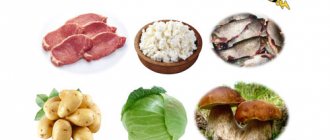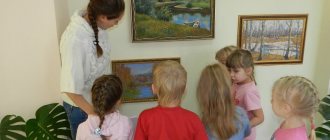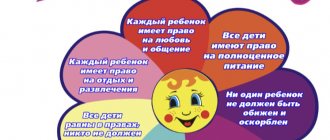"What's more important?" A fairy tale for kids on the topic “Clothes and shoes”
Natalia Dementieva
“What is more important?” A fairy tale for kids on the topic “Clothes and shoes”
There was a child's dress and shoes. For a long time they had been arguing among themselves about who was more beautiful and more useful to the girl Masha.
They would have been arguing until now, but then Mashenka woke up. She got up from her crib, stretched and began to put on her dress, saying: “Today in kindergarten I will be the most beautiful, because I have such a magnificent dress!”
-Here you go! I told you that he is more important and more beautiful than you ! - the dress said to the shoes .
And suddenly the girl went to the mirror, looked at herself and thought:
- No, I won’t be beautiful in just a dress... But I’ll put on these wonderful shoes. They are very comfortable and complement my outfit perfectly.
And Mashenka, putting on her shoes and dress, pleased with herself and her beauty, went with her mother to kindergarten.
Didactic games for preschool children on the topic “Clothes, shoes, hats” Municipal budgetary preschool educational institution kindergarten “Baby”. Didactic games for preschool children.
Calendar plan on the topic “Clothes, shoes, hats” (preparatory group) Topic of the week: “Clothes, shoes, hats, atelier. Goal: to reinforce with children the names of clothes for different seasons of the year, hats (how.
Consultation “Clothes and shoes for children on a winter walk” Consultation for parents “Clothes and shoes for a child on a winter walk” Colds are a common occurrence among children attending kindergarten. Often.
GCD for FCCM “Footwear. Cloth. Hats" GCD for FCCM Topic: "Footwear. Cloth. Hats". Goal: 1. to develop the ability to differentiate types of clothing by season; call her.
GCD in a preparatory group for school on the lexical topic “Clothes, shoes, hats” Objectives: 1. Clarify the meaning of the verbs “shoe” and “dress” 2. Develop the ability to compose comparative stories using the conjunction “a”. 3. Fasten.
Speech development. GCD summary on the topic “Clothing, shoes, hats” GCD summary on the topic: “Clothing, shoes, hats.” Program content: Enrich vocabulary on the topic “Clothing”. Develop thinking.
Thematic week “Clothes. Shoes. Hats" Notes on speech development in the senior group "Clothing" Purpose: To familiarize children with the purpose of clothing. Develop the ability to classify types of clothing. Introduce the professions of tailor and knitter. Exercise.
Source
Jacket with secret
In one big city there lived a little boy who did not like to wear outerwear. All kinds of jackets and overalls were offered to him - with cars, and with astronauts, and blue, and red, and yellow, and different ones. But the baby didn’t like any of them!
— I don’t like jackets, I don’t like getting dressed! - the little boy just repeated to his parents.
It got to the point that even in winter the baby refused to put on a warm jacket or fashionable overalls. Mom and dad were very upset because instead of going out with the baby, everyone was forced to stay at home. You can't leave home without a jacket in winter.
And there is such beauty outside - sleds, slides, snow, icicles! How great it is to walk in the fresh frosty air and not freeze in your warm jacket. One day, when the boy once again refused to put on outer clothing, she suddenly spoke to him in a human voice.
- Hello, my friend! What a pity that you don't like me. “I have a secret mission, but I can’t do it without your help,” said the jacket.
- Hello! And how can I help you? — the kid was surprised.
“If you put me on, we can go outside with you and launch a secret message into space,” the jacket answered.
- Into the space? So how do we do this? — the boy suddenly became interested.
- Very simple! - answered the jacket. - Here's a magic paper airplane for you. You put it in one of my pockets and put it on me. And when you go outside with your parents, take out an airplane and launch it straight into the sky. He will definitely reach space, and you and I will be the heroes who successfully completed the secret mission!
The boy really liked this idea. He put on his jacket and put a small paper airplane in his pocket.
- Mom, dad, I'm waiting for you! “Let’s go for a walk,” the baby called to his parents.
When mom and dad saw the boy dressed in a jacket, their joy knew no bounds. The parents also quickly got ready, and everyone went outside together. There, the kid launched a magic airplane into space and has since fallen in love with his jacket.
After all, with her outside it is not only warm, but also very interesting. Now almost every day the boy and the jacket completed secret missions and rejoiced at their success.
Conversation in the middle group of a preschool educational institution “Where did clothes come to us from?”
Conversation with middle group children:
Topic: “Where did clothes come to us?”
Goal: To introduce children to the history of clothing. Systematize children's knowledge about the purpose of different types of clothing. Introduce the methods of its production. Promote the development of cognitive abilities. Foster a respectful attitude towards the work of adults.
Material: various pictures with items of clothing (exhibited on the typesetting canvas during the conversation).
Progress of the conversation
- Guys, let's remember the fascinating and instructive fairy tale by K. I. Chukovsky “Moidodyr”.
-What happened to the hero of this fairy tale? That's right, all the clothes, toys and furniture ran away from him.
- Do you remember why this happened? Yes. The boy Kolya did not take care of his things, did not wash them, did not clean them.
How do you think. Is clothing worthy of respect? (Children's answers).
Do you know when clothes appeared on earth and what they looked like?
(Children's answers)
To protect his body from cold and rain, ancient man covered it with animal skins and plant leaves. Later, man began to wrap his body with a specially woven piece of fabric, rectangular or oval. It was secured to the figure with pins. Such clothes not only protected, but also decorated a person. Soon man learned to make clothes from rectangular pieces of fabric connected by seams, and later clothes began to be cut to the shape of a person’s figure. Tailors learned to make clothes with sleeves, collars, and pockets. They divided the clothes into a bodice and a skirt, so a new type of women's costume appeared, in which the human figure was even more emphasized. Now fashion designers are coming up with clothes that are comfortable to wear to work, on hikes, on holidays, to play sports, at different times of the year and in different weather. (The teacher’s story is accompanied by showing illustrations of clothing in various historical periods)
-Was clothing made from animal skin comfortable? Why? (does not hold well, gets wet, takes a long time to dry)
“Would a primitive man envy us?” After all, there are so many clothes now for every taste! (These are dresses, T-shirts, shirts, shorts, trousers, sweaters... children's answers)
I suggest you play the game “Place them in order.” I will hand out pictures, you put them in order: what happened before, what was invented later, etc. The teacher hands out pictures depicting clothes made from leaves, from animal skins, from fabric. (Children work in groups of 4.)
Do you know the name of the profession of a person who cuts clothes (Tailor)
- Who sews our clothes? (Seamstress)
-What are clothes made from? (Textile)
-Guys, how many of you know what tools are used to make clothes?
- using a thread,
- using a needle,
- scissors,
- buttons and decorations.
Physical exercise.
And now you and I will stand in a circle and imagine that we are sewing a dress. I will show you, and you repeat after me.
The teacher and children form a circle and walk, saying:
In an even circle, one after another
We go step by step, stand still, together
Let's do it like this...
The teacher shows the actions (threading a needle, cutting with scissors, sewing, sewing on a button), and the children repeat and name its action.
- Well done, guys! We have sewn a beautiful dress for you.
Game "What's extra?"
Educator. - I will give you cards with pictures of four objects, three of which are objects with which you can make clothes, and one cannot. You must identify an item that is not suitable for making clothing.
The teacher distributes cards
- scissors, thread, hammer, button.
- needle, scissors, chair, thread.
- button, thread, table, needle.
- thread, needle, cabinet, scissors.
Bottom line: what interesting things did you learn about clothes today? What were the very first clothes made of? Can people live without clothes?


